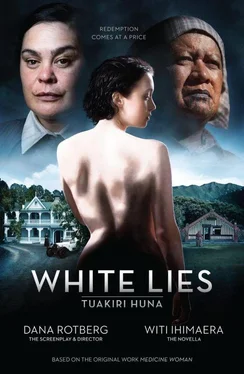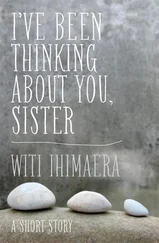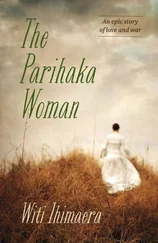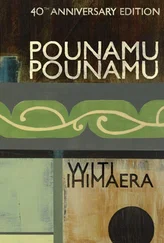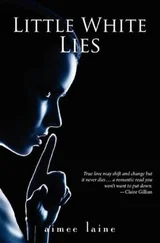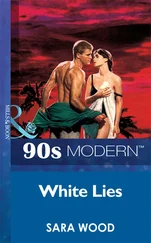It was so wonderful for Paraiti to be back among the people who had given sanctuary to her and Te Teira those many years ago. No sooner had she arrived than she was ordered by the great chief, Whaturangi, to pitch her tent close to Te Tokanganui a Noho, the great ‘unification’ marae, prototype for most of the later Ringatu meeting houses. ‘Your dad would be cross with us if we didn’t acknowledge you,’ her cousin Peti growled, ‘and there are enough angry ghosts floating around us as it is.’ Indeed, in Paraiti’s honour, a special remembrance service was held for Te Teira in the meeting house. Sitting there, within the latticed walls and with the beautiful painted kowhaiwhai rafters soaring above her, Paraiti again honoured the morehu, the loyal remnants of Te Kooti, survivors in a changing world.
Then it was down to business again. A stream of patients waited for a consultation, with Peti at the flap of the tent. A young man with a broken leg would now be able to walk, following Paraiti’s skilful manipulation of his bones. An older forester, who had chopped off three fingers of his right hand, had the wounds cauterised. A child with chronic asthma would now breathe more easily if he followed the regime of herbal inhalants and exercises that Paraiti gave his anxious parents. A young girl was brought in covered in pustules; Paraiti looked after her during the night, using her poultices to draw out the pus and her soporifics to bring down the girl’s fever. And if Paraiti was not able to cure all those who sought her help, at least she had tried to make them more comfortable.
From Te Kuiti, Paraiti cut across to the lands of Te Whanau a Apanui: Te Teko, Whakatane, Te Karaka and Ohiwa Harbour. More patients, more successful diagnoses and treatments, and always humour, as people laughed in the face of their illness or impending death. Like the old kuia, wasting away; when Paraiti inspected her, she was horrified, saying: ‘E kui, you are all skin and bones.’ To her, Paraiti had given a strong herbal painkiller, her skilful massaging hands, and the gift of a few more precious days to breathe and to praise the Lord.
Then, just after leaving her clinic at Ohiwa Habour, Paraiti had a disturbing dream. The dream was a jumble of chaotic images. A face on fire — it was her face. A ngarara bearing down on her; she took up her rifle and shot at it. As the ngarara went by, Paraiti saw a woman with auburn hair coiled within the ngarara’s slithering entrails. Then Charlie Chaplin appeared — how did he get into her dream? He was in a hut and it was see-sawing on the edge of a cliff. But it wasn’t Charlie Chaplin at all — it was Paraiti herself. Suddenly, as the hut slid over the cliff, Te Teira appeared, put a hand out and pulled her out of the hut. He cupped Paraiti’s chin in his hands and wiped her face clear of the scar. He did this again and again.
Paraiti woke up puzzled and anxious. What did the dream mean?
The dream gnawed at Paraiti as she travelled around the coastline from Opotiki to Omaramutu, Torere and Maraenui. Wherever she went, she performed her healing duties. As for Tiaki, Ataahua and Kaihe, they loved swimming in the sea. Paraiti took Tiaki fishing with her in a favourite lagoon. She speared a fish and let the spear sink with the fish down to the bottom. ‘Kia tere,’ she commanded Tiaki. Immediately he dived after the speared fish, swimming down, down, down until he was able to grasp the spear in his teeth and return to the surface.
Camping on the beach one evening, Paraiti saw an uncommonly bright star blazing across the sky. That night she had the dream again. It had changed in two respects: the auburn-haired woman had now become the ngarara, and it was a child who was caught in its slithering shape.

This morning, Paraiti is waiting for Tiaki to bring her breakfast. Perhaps he has gone fishing without her and will bring her back a nice silver-finned kahawai. Of course she will have to throw it back into the sea — first fish to Tangaroa — but the thought of a fish for breakfast is enticing. She leaves her tent to get some driftwood together for a fire to boil water for her manuka tea. She puts the skillet on the fire so it will be ready for Tiaki’s catch.
As she is ranging along the beach, with the surf rolling in, she sees an old koroua sitting on a log in the middle of a vast expanse of sand. He is smiling at her and waving to her as if he knows her.
As soon as she sees him, Paraiti’s heart bursts with pain and love. She drops her driftwood and runs towards him like a young girl. When she gets nearer, he motions her to sit down next to him.
‘Hello, daughter,’ Te Teira says. ‘Isn’t it a lovely morning?’
Paraiti smiles at him. ‘Yes, Dad.’
He closes his eyes and sniffs the sea air. ‘Mmm, kei te whiti te ra, such a day brings back so many memories, daughter.’ Then he looks at Paraiti again, and she can feel herself drowning in his eyes, irradiated with his love. ‘You always had good hands, daughter. They can save lives and they can heal people. You know what you have to do.’ Then he is gone.
After breakfast, Paraiti talks to her animals. ‘Well, Tiaki, Ataahua and Kaihe, I know you are expecting us to head southward to Ngati Porou, and I know you like to visit kin at Tikitiki, Tokomaru Bay, Tolaga Bay and Whangara, but we have to cancel our travels; maybe we’ll go to Ngati Porou another day. Instead, we will go straight home.’
The animals simply look at her with a puzzled expression. So? What are we waiting for? Let’s get going.
Paraiti puts on her wide-brimmed hat. She packs the saddlebags, says a karakia on the beach and sprinkles sea water over her head and those of her animals. She taps Ataahua on his knees and mounts him.
It will be a long, hard ride. She wants to send a telegram from Opotiki and be at the Waioeka Gorge by nightfall, and reach Gisborne in two days’ time, if all goes well.
Better get a move on. ‘Me hoki matou ki te wa kainga,’ she orders.
The waves thunder and spray around her as she heads inland.
Two days later, and Mrs Rebecca Vickers waits in the upstairs drawing room of her home on Waterside Drive.
She is smouldering with irritation. Yesterday, Maraea had brought news that Scarface had telegraphed from Opotiki to say that she was returning to Gisborne, and had a matter of mutual benefit to discuss. An appointment has been arranged for this evening.
Mrs Vickers wears her auburn hair unpinned. She is dressed in a long crimson robe. Her full and generous pregnancy is clearly showing. Her backbone has curved to make space for the baby, and all the other organs have found their places around the whare tangata.
All her attempts to end her pregnancy have failed. The last butcher left her for dead on the bathroom floor. But the baby is still alive inside her.
Lighting a cigarette, she looks out the window. The day is already beginning to wane. She rings the bell for Maraea and tells her to bring the latest edition of The Tatler and switch on a reading lamp. The magazine has a full-page photograph of a young film actress, Merle Oberon: rich black hair, high noble forehead, exquisite cheekbones, the neck of a swan, and skin of unsurpassed whiteness. Regarded as the quintessential English rose, Merle Oberon is the woman of her generation — looks, style and manners — on whom Rebecca Vickers has modelled her own image. Opalescent eyes blazing, she throws the magazine to the floor. Waiting for Paraiti, she broods, eyes unblinking. If she doesn’t play her cards right, everything will be over. Everything.
What is Mrs Vickers’ secret? She has been passing for white ever since she was a young girl of twelve. Her father was English, her mother a Maori woman he met in Auckland and promised to marry but didn’t. Rather than return to her kainga, Mrs Vickers’ mother instead fled to Christchurch, where her daughter was born out of wedlock. Mrs Vickers is therefore a halfcaste. In other countries where interracial relationships — or miscegenation — lead to children, those children are called, by blood quantum, halfbreed, Eurasian, mulatto or quadroon. But Mrs Vickers is more white than brown. Pigmentocracy has enabled her to blend in and thus assure for herself all the benefits of being Pakeha. So began, with her mother’s connivance, her process of crossing over the colour bar.
Читать дальше
